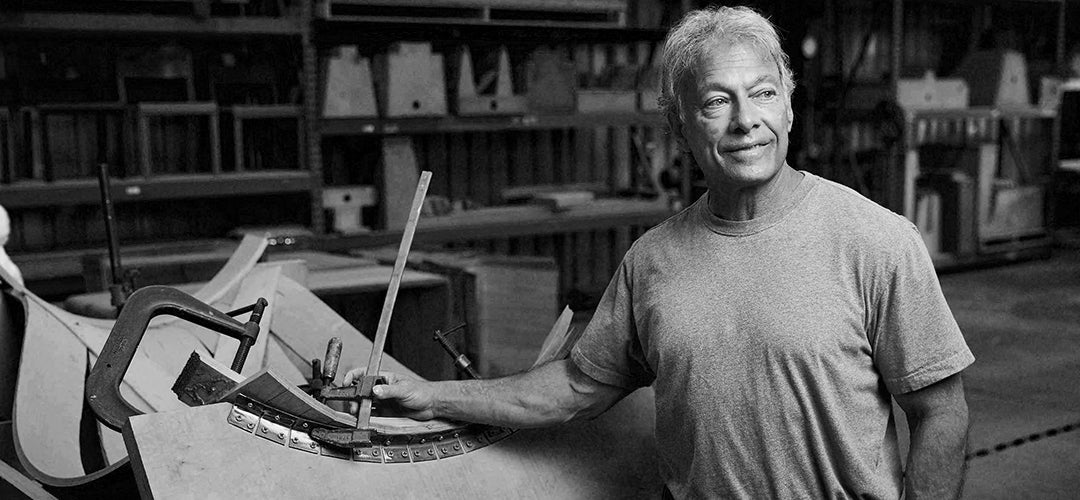On Art, Collaboration, and the Idiosyncrasies of Wood
On an atypical overcast October day in Southern California, I had the delightful opportunity to speak with Jay Novak, co-founder (along with his brother Frank) of Los Angeles-based furniture design company Modernica, on a few things design and process.
Autotype: To start, why post-WWII California design?
Jay Novak: The purity and architecture of the time, the geometry of archetypal shape. Not because it was mid-century, but because appreciation for it emerged after WWII in a strong way.
AT: What’s the process of creating a project today versus when you first started?
JN: Thirty years ago, I was just coming up with an idea and trying to build it. Now, it’s much more collaborative; collaboration was a skill that I had to learn. Our team now has seven to eight people, all with varying levels of input on any given project. Sometimes one person’s concept is dominant, with others adding little nuances here and there, and other times the collaboration is more equal. We pride ourselves on working fast, and the timeframe for a project from concept to completion can be anywhere from 90 days to a year.
AT: So there’s an amazing collection of American classics at Modernica Props. I’d love to know what’s your favorite piece, why, and how you found it.
JN: My favorite piece is a coffee table by John Keogh, made in Los Angeles. I love it because it has its own unique architecture and thinking-outside-the-box aesthetic. In 1995, someone pulled up with it on the back of a pick-up truck. It looked like it came straight from a curb or possibly the trash. It obviously wasn’t popular in its day, and nobody has made anything like it since.
(Insert a small bit of jealousy here.)
AT: On my visit to Modernica, one of the amazing bent-wood molds caught my eye. I was completely fascinated by it. Can you tell me a little about the process of how you bring it to life?
JN: The creation of the mold is art and collaboration, knowledge of geometry and calculus, and the idiosyncrasies of wood. Each type of wood behaves differently when bent, and on some days it does different things. We start with a physical 3D model prototype—it’s how we like to work. Once we get it to a place we like, then we’ll create a drawing with measurements. Moving on to the building of the final mold is still incremental steps in trial and error. When you’re dealing with radii, it gets to be a lot of trial and error and adjusting.
The molds are made of sheets of plywood, with more complicated shapes having articulated parts. The alpine chair design took a year because we actually had to develop new technology to accommodate the project.
AT: My favorite classic chair combination is the Fiberglass Shell Chair and the Spyder™ base. How long did it take you from concept to completion, and what made you think the chair needed a new pair of “legs”?
JN: It took 15 years. I envisioned it for a long time but didn’t have the ability to make it. I liked wood, but the dowel leg with its X’s seemed archaic. I thought, what would be the simplest set of legs that match the chair? The wood also adds an organic touch to the consumer usage of plastic (fiberglass).
AT: This segues nicely into my next question. Favorite wood?
JN: Rosewood. I have a chunk of it I just like to look at it since it’s not environmentally responsible to use. A few of the early Finn Juhl’s Chieftain Chairs made of rosewood are just beautiful structures.
AT: What’s a project you would have loved to work on, and with which designer?
JN: I would’ve loved to work with Charles Eames for his ability to distill solutions to their purest level.
AT: Of course, I have to ask, your favorite Case Study house?
JN: #18 by Craig Ellwood. It’s a tutorial and prototype for prefabricated housing that would provide middle class affordability and stunning architecture.
AT: We have a scholarship program at Autotype. I’m sure the students would love to know which are your favorite schools?
JN: Harvard Architecture…They’re all good. But Cal-Poly Pomona, USC, UCLA, and Cal-Poly San Luis Obispo are my favorite because they’re local. I’m familiar with the work that comes out of the schools and it’s all futuristic. It’s architecture that is improving people’s lives.
Thanks Jay!


